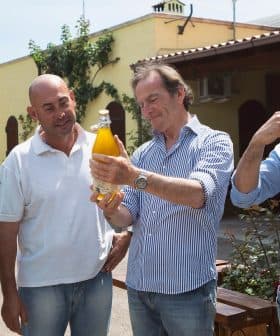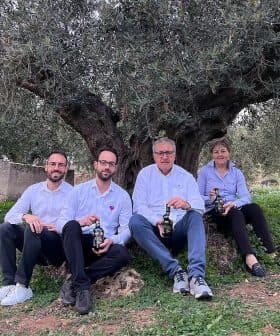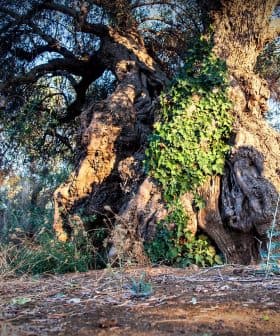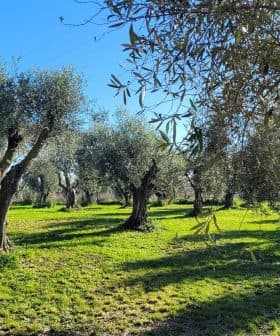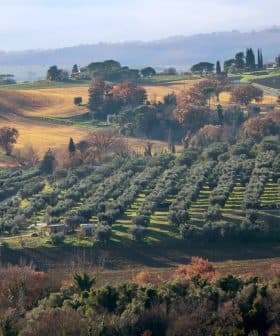Authorities Identify Xylella Strain Infecting Vines, Almonds in Puglia
The new variant was detected in a region already severely affected by Xylella fastidiosa pauca.
 Almond harvest in the Molfetta, Italy (AP)
Almond harvest in the Molfetta, Italy (AP) A new strain of the bacterium Xylella fastidiosa fastidiosa has been identified in almond trees in the Italian region of Puglia, prompting local authorities to implement containment protocols and further monitoring. The discovery has raised concerns about the potential impact on the region’s agriculture, with calls for a united effort at local, national, and European levels to address the threat posed by the new strain.
The task force monitoring Xylella fastidiosa in the southern Italian region of Puglia has identified a new strain of the bacterium in the central commune of Triggiano.
By analyzing samples taken in 136 locations, local experts found the fastidiosa subspecies (Xylella fastidiosa fastidiosa) in six almond trees. It is the first time the strain has been identified in the Italian region.
We must eradicate the new strain of the bacterium immediately, as it is capable of attacking grapevines. If this were to happen, it would be a mortal blow to agriculture in Puglia.
Given its potential as a pathogen for various plants, local authorities noted that containment protocols, including eradicating the infected trees, analyzing the newly found bacteria and further monitoring, will be conducted.
“The discovery of this new bacterium stems from extensive, precise and careful monitoring carried out by the agriculture department,” Donato Pentassuglia, the regional secretary to agriculture, told local media.
See Also:New Spray Could Protect Olive Trees from Xylella“At this moment, there is a need for a unity of purpose and activity to support the phytosanitary security of the region,” he added. “Now, we must extinguish the outbreak promptly by eradicating the bacterium. There is no need for alarmism, but it is necessary to remain vigilant.”
Pentassuglia said researchers still do not know how aggressive or infectious the new strain is but warned that extra precautions surrounding the pests that transmit the disease, especially those that prey on grapes, must be taken.
The infected plants identified by authorities are located outside Puglia’s red and buffer zones to contain a different strain of Xylella fastidiosa, the pauca subspecies.
Over the past decade, Xylella fastidiosa pauca has caused the death of millions of olive trees across southern Puglia.
According to the European Food Safety Authority, Xylella fastidiosa fastidiosa is not known to infect olive trees naturally. However, the subspecies is well known in the Americas for causing the deadly Pierce’s disease in several crops, such as grapevines.
Since its emergence at the end of the 19th century, Xylella fastidiosa fastidiosa has remained a significant threat to the United States wine industry.
Current models predict a modest global expansion of Pierce’s disease in the next 20 years, primarily due to the international plant trade, which expands the geographic range of the pathogen.
Difficult to detect and often identified only after a long time from the initial infection, Xylella fastidiosa is actively spread by several vector insects.
Puglia is a large wine producer and exporter. Other potential targets of the subspecies fastidiosa include almond and cherry trees, both broadly grown in the region.
Salvatore Infantino, director of the regional phytosanitary observatory, told local media that the U.S. Xylella fastidiosa epidemic and the Apulian outbreak might still follow very different paths.
“The potential aggressiveness [of the newly found strain] depends on many factors, such as the characteristics of the infected areas,” he said.
Gianluca Nardone, director of Puglia’s agricultural department, said the scientific network working with the local authorities on Xylella fastidiosa would determine the origin of the fastidiosa strain, its virulence and the potential damages it could cause to the local territory.
“Xylella fastidiosa fastidiosa is currently present in Europe, according to the EPPO Global Database, in Portugal and the Balearic Islands,” he said.
“We must eradicate the new strain of the bacterium immediately, as it is capable of attacking grapevines,” added Gennaro Sicolo, president of the Italian Confederation of Farmers (CIA). “If this were to happen, it would be a mortal blow to agriculture in Puglia.”
According to Sicolo, a comprehensive approach to the new menace must be developed “through more decisive and systematic support for scientific research, creating and strengthening an international network capable of finally finding effective solutions. Such checks will allow us to address the new danger.”
A call for local, national and European authorities to join forces to contain the impact of the bacteria came from several farming organizations.
In a note, Coldiretti Puglia, a farmers’ union, said a review of the current European regulations about plant imports should be immediately promoted, given the potential severity of outbreaks such as the infection identified in Triggiano.
Share this article


